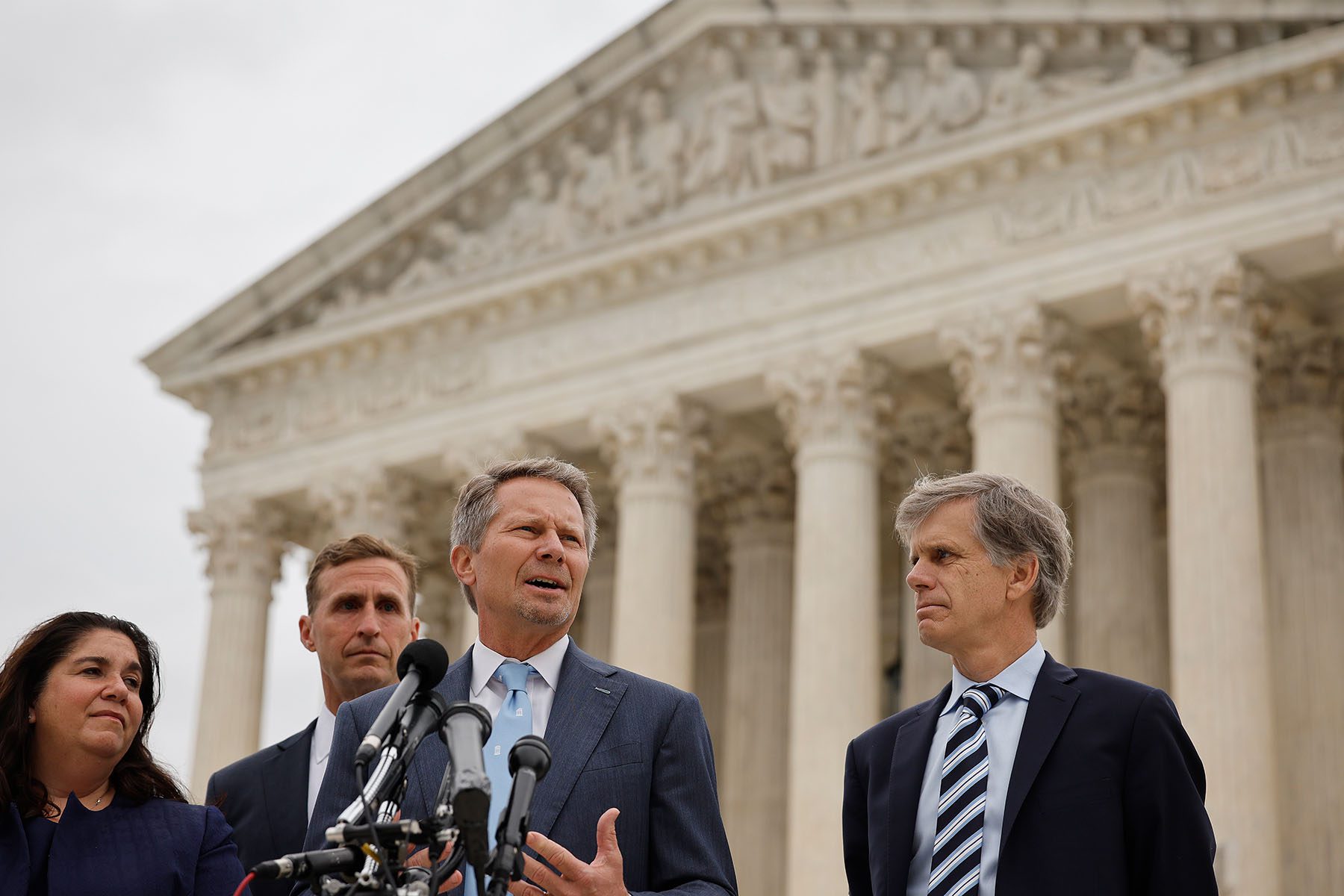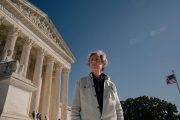Monday’s oral arguments in two Supreme Court cases over the future of affirmative action at public and private universities highlighted a confluence of big moments for three of the court’s women justices. This October session is the first time the liberal side of the court is represented by all women, each of whom has held a position in government as a historic first.
As a multiracial group, the three justices reflect the kind of women throughout the country who have been supported by such programs. Justice Sonia Sotomayor herself has said in the past that she is a “product of affirmative action.”
Justices Elena Kagan, Sotomayor and Ketanji Brown Jackson joined their six conservative colleagues to hear oral arguments for and against affirmative action policies meant to facilitate racial diversity in higher education.
At the heart of the two cases — Students for Fair Admissions, Inc. v. President and Fellows of Harvard College and Students for Fair Admissions, Inc. v. University of North Carolina (UNC) — is a key question: If the nation’s highest court prohibits schools from considering an applicant’s race in their admissions process, how would this limit students’ ability to acknowledge their identities?
Women represent about 60 percent of enrollment in universities and colleges around the country. College-degree attainment for Black and Latina women, in particular, has significantly outpaced that of their male counterparts. As a result, any decision restricting the consideration of race in school admissions would disproportionately affect women of color.
-
More Like This:
Affirmative action is a policy that has helped expand race and gender make up the country’s professionals, said Liliana M. Garces, who teaches higher education law and policy at the University of Texas at Austin. “It’s kind of ironic that we’re at this stage now where we have a Supreme Court that has been diversified thanks, in part, to this policy and that it could end with this decision.”
Both cases consider the constitutionality of admissions practices that were borne out of the civil rights movement and seek to remedy past and current structural barriers for people of color. These cases also come at a time of nationwide efforts to push teachings about structural racism out of education.
Jackson recused herself from the Harvard case because she served as a member of Harvard’s Board of Overseers, but weighed in for the UNC case.
UNC argues that it uses a holistic assessment of applicants. Race is one of dozens of factors, including socioeconomic status, military background and geography, that the school considers among qualified applicants in order to diversify its student body.
SFFA, a student group representing mostly Asian-American families but led by a White conservative activist, argues that affirmative action policies discriminate against Asian and White students.
According to UNC’s website, their most recent undergraduate class is 65 percent White, 22 percent Asian or Asian American, 10 percent Black, 10 percent Hispanic or Latinx and 1 percent Native American or Alaska Native. Based on this and Census data, Asian Americans are overrepresented in the UNC student population compared with their numbers in the general North Carolina population, and Black people are underrepresented in the UNC student population.

In his oral argument representing SFFA’s position against race-conscious admissions, attorney Patrick Strawbridge said that the country has barred racial classifications in other aspects of society, but affirmative action remains a glaring exception.
“Just considering race and race alone is not consistent with the Constitution,” Strawbridge said.
Sotomayor quickly jumped in. “Sometimes race does correlate to some experiences and not others,” she said. “If you’re Black you’re more likely to be in an under-resourced school … you’re more likely to be viewed as having less academic potential.”
Jackson challenged the idea that race alone determines whether an applicant is accepted into the school. “What are the facts here about whether or not race is being used singularly to let people in?” she said.
Strawbridge did not provide specific examples but cited a UNC expert’s testimony in a lower court hearing that determined that race plays a role in 1.2 percent of UNC’s in-state student admissions and 5.1 percent for out-of-state students. He added that SFFA’s own expert determined that 700 applications are affected each admissions cycle. Strawbridge asserted that UNC has ignored race-neutral alternatives to affirmative action, though the university said it regularly considers them. Education policy experts previously told The 19th that race-neutral alternatives have not proven to promote the same level of racial diversity as race-conscious admissions.
Sotomayor, seemingly aware of this research, noted at one point that alternatives offered by SFFA as evidence at the trial court level showed dramatic decreases in Black enrollment.
Throughout the oral argument, SFFA’s position focused specifically on removing race as a factor for consideration in admissions. Considering other factors such as socioeconomic or military status would be permissible by the Constitution, Strawbridge stated.
Jackson and Sotomayor repeatedly pressed Strawbridge to demonstrate how UNC’s admissions process harms Asian and White students when race is one of 40 factors the school considers.
What remained unclear in SFFA’s arguments is how applicants from underrepresented backgrounds would be able to speak to their lived experiences if race-conscious admissions are no longer permitted.
-
More from The 19th
- The midterms, a milestone and the myth of the monolith: How 2022 could build on women’s representation
- The fights for the vote and bodily autonomy are connected. So are the women who are telling us how.
- Stacey Abrams wants more Georgians with disabilities to be able to live independently
In one standout moment, Jackson expressed concern that if SFFA succeeds in overturning race-conscious admission in schools, institutions would be allowed to consider all other factors except race, and would therefore disadvantage students of color and potentially clash with the federal Equal Protection Clause.
She used a hypothetical situation in a post-affirmative action world in which one applicant might write an essay stating that their family has lived in North Carolina and attended UNC for generations, and that they want to honor their family’s legacy by also attending as a fifth-generation student. Another student might write that they come from a Black family that has lived in the state for generations but historically has not had the opportunity to attend the university and they want to honor their family by being the first member to do so.
“As I understand your ‘no race-conscious’ admissions rule, these two applicants would have a dramatically different opportunity to tell their families’ stories and to have them count,” Jackson said, adding that one person’s story and family history is tied to race.
“I think this spoke to a lot of the points that UNC is also trying to make, saying, ‘We have a race-conscious process that allows all applicants to present their full selves to admissions officers,’” Garces said. “To say that race cannot be one of those pieces that students can bring to the table would end up preventing certain students from being able to present their full experience.”
When it came to UNC’s defense of race-conscious admissions, the six conservative justices zeroed in on an opinion written by the country’s first woman Supreme Court justice, Sandra Day O’Connor, when the court heard another affirmative action case, Grutter v. Bollinger, in 2003.
In her opinion, O’Connor said that race-conscious admissions policies must be limited in how long they last, adding that she would expect the use of race consideration to no longer be necessary in 25 years, by the year 2028.
Justices Samuel Alito and Amy Coney Barrett, along with Chief Justice John Roberts, repeatedly asked UNC’s attorney, North Carolina solicitor general, Ryan Park, to explain when the time will come for affirmative action to end.
These questions signaled a potential focus point for the conservative opinion when the justices make their final decision this spring.
Later on Monday, the justices minus Jackson heard arguments in the Harvard case in which SFFA is similarly seeking to bar race-conscious admissions in private universities.
The two cases represent the first time affirmative action policies are being challenged at both public and private institutions simultaneously on the high court. Experts told The 19th that with a six-to-three conservative supermajority, the Supreme Court is poised to undo legal precedent that has protected affirmative action for more than 40 years.
“What’s really at stake now is that there’s a lot of concern that since we now have a court that’s six-three conservative-to-progressive that they will outright prohibit or at least restrict the ability to consider race in student admissions,” Lourdes Rosado, president of LatinoJustice, a national civil rights organization, previously told The 19th. “It’s very worrisome because we know that from past experience that, when you do not allow a university to consider race, that the number of people from that race in the student body will plummet dramatically.”
Nadra Nittle contributed reporting.








